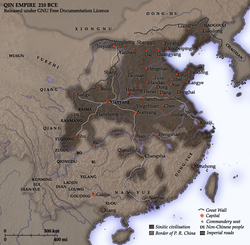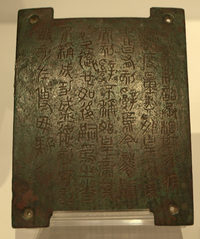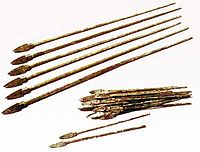
Qin Dynasty
About this schools Wikipedia selection
SOS Children volunteers helped choose articles and made other curriculum material Child sponsorship helps children one by one http://www.sponsor-a-child.org.uk/.
- Not to be confused with the Qing Dynasty, the last dynasty of China.
| The Qin Dynasty 秦朝 |
|||||
|
|||||
|
Qin Dynasty in 210 BC
|
|||||
| Capital | Xianyang | ||||
| Languages | old Chinese | ||||
| Government | Monarchy | ||||
| History | |||||
| - | Unification of China | 221 BC | |||
| - | Death of Qin Shi Huangdi | 210 BC | |||
| - | Surrender to Liu Bang | 206 BC | |||
| History of China | |||||||
|---|---|---|---|---|---|---|---|
| ANCIENT | |||||||
| 3 Sovereigns and 5 Emperors | |||||||
| Xia Dynasty 2100–1600 BC | |||||||
| Shang Dynasty 1600–1046 BC | |||||||
| Zhou Dynasty 1045–256 BC | |||||||
| Western Zhou | |||||||
| Eastern Zhou | |||||||
| Spring and Autumn period | |||||||
| Warring States period | |||||||
| IMPERIAL | |||||||
| Qin Dynasty 221 BC–206 BC | |||||||
| Han Dynasty 206 BC–220 AD | |||||||
| Western Han | |||||||
| Xin Dynasty | |||||||
| Eastern Han | |||||||
| Three Kingdoms 220–280 | |||||||
| Wei, Shu and Wu | |||||||
| Jin Dynasty 265–420 | |||||||
| Western Jin | 16 Kingdoms 304–439 |
||||||
| Eastern Jin | |||||||
| Southern and Northern Dynasties 420–589 |
|||||||
| Sui Dynasty 581–618 | |||||||
| Tang Dynasty 618–907 | |||||||
| ( Second Zhou 690–705) | |||||||
| 5 Dynasties and 10 Kingdoms 907–960 |
Liao Dynasty 907–1125 |
||||||
| Song Dynasty 960–1279 |
|||||||
| Northern Song | W. Xia | ||||||
| Southern Song | Jin | ||||||
| Yuan Dynasty 1271–1368 | |||||||
| Ming Dynasty 1368–1644 | |||||||
| Qing Dynasty 1644–1911 | |||||||
| MODERN | |||||||
| Republic of China 1912–1949 | |||||||
| People's Republic of China 1949–present |
Republic of China (Taiwan) 1949–present |
||||||
|
Related articles
Chinese historiography |
|||||||
The Qin Dynasty (Chinese: 秦朝; pinyin: Qín Cháo; Wade–Giles: Ch'in Ch'ao) ( 221 BC - 206 BC) was preceded by the feudal Zhou Dynasty and followed by the Han Dynasty in China. The unification of China in 221 BC under the First Emperor Qin Shi Huangdi (or Shih Hwang-Tih) marked the beginning of Imperial China, a period which lasted until the fall of the Qing Dynasty in 1912. The Qin Dynasty left a legacy of a centralized and bureaucratic state that would be carried onto successive dynasties. At the height of its power, the Qin Dynasty had a population of about 40 million people. Also, the massive Terracotta Army at Xi'an was built during the Qin as a royal retinue to guard the First Emperor in the afterlife.
Origins
Before it is referred to as the Qin (chin) Dynasty, the Ying were the rulers of the Qin (state). According to Sima Qian, the house of Qin traced its origin to Emperor Zhuanxu (one of the five emperors of the legendary times). One of their ancestors, Dafei received from Emperor Shun the surname Ying. Another ancestor, Feizi served King Xiao of Zhou as the royal horse trainer, was rewarded with a fief in Quanqiu (today's Tianshui, Gansu province); the Qin state grew out from this area, and the Qin name itself is believed to have originated, in part,there.
Qin Shi Huangdi
Qin Shi Huangdi imposed the Qin state's centralized, non-hereditary aristocratic system on his new empire in place of the Zhou's quasi-feudalistic one. The Qin Empire relied on the philosophy of legalism (with skillful advisors like Han Fei and Li Si). Centralization, achieved by ruthless methods, was focused on standardizing legal codes and bureaucratic procedures, the forms of writing and coinage, and the pattern of thought and scholarship. The seal scriptcharacters from the former state of Qin became the standard for the entire empire. The length of the wheel axle was also unified and expressways standardized to ease transportation throughout the country. To silence criticism of imperial rule, the emperor banished or put to death many dissenting Confucian scholars and confiscated and burned their books.
To prevent future uprisings, Qin Shi Huangdi ordered the confiscation of weapons and stored them in the capital. In order to prevent the resurgence of feudal lords, he also destroyed the walls and fortifications that had separated the previous six states. A national conscription was devised: every male between the ages of seventeen and sixty years was obliged to serve one year in the army. Qin aggrandizement was aided by frequent military expeditions pushing forward the frontiers in the north and south. To fend off a barbarian intrusion (mainly against the Xiongnu in the north), the fortification walls built by the various warring states were connected to make a wall; this is usually recognized as the first Great Wall of China, although the present, 4,856- kilometer-long Great Wall of China was largely built or re-built during the Ming Dynasty. A number of public works projects, including canals and bridges, were also undertaken to consolidate and strengthen imperial rule. A lavish tomb for the emperor, complete with a Terracotta Army, was built near the capital Xianyang, a city half an hour from modern Xi'an. These activities required enormous levies of manpower and resources, not to mention repressive measures.
Qin Shi Huangdi's behaviour reportedly became increasingly erratic in the later years of his rule. This may have been the result of drinking solutions containing mercury as well as other deadly compounds. Ironically, Shi Huangdi ingested the mixtures in an increasingly desperate search for an elixir that would prolong his life. It has often been speculated that this was at least partially responsible for many of his later acts such as building the terracotta army.
Campaigns against Xiongnu
When Emperor Qin Shi Huangdi had succeeded in his conquest of all the six warring states in China he began to concentrate its aggression against the nomadic ethnic Xiongnu which had grown into a powerful invading force in the north and started expanding both east and west. Qin Shihuang, the first emperor of the Qin Dynasty, sent a 300,000-strong army headed by General Meng Tian to drive the Xiongnu northward for 350 km and built the Great Wall to guard against its invasion.
Burning of intellectual books and Confucian burying
Qin Shi Huangdi had allowed the burning of intellectual books and burying Confucians alive when Li Si (Li Szu), his prime minister, had won favour over Chunyu Yue on the matter of commandary-county system, proposed book burning. In 213 BC, on Li Si's urging, Qin Shi Huangdi outlawed all other schools of thought ("Hundred Schools") except for Legalism, and he ordered book burning. 346 to 460 Confucians local to Qin capital were buried alive at one time. When Qin Shi Huangdi's elder son, Prince Fusu, encountered the rows of Confucians who were on the way to the burial ground, he went straight to Qin Shi Huangdi pleading for amnesty on behalf of the Confucians. Qin Shi Huangdi rebutted Fusu and further sent his elder son to Shangjun (today's Suide and ancient Suizhou) Commandary on the northern border to be with General Meng Tian. Qin Shi Huangdi then played a trick to have various prefectures send over about 700 more Confucians and scholars. All 700 Confucians were stoned to death in a valley, a place later named "valley of Confucian killing".
Second Emperor
During the last trip with his youngest son Huhai in 210 BC, Qin Shi Huang died suddenly at Shaqiu prefecture. Huhai, under the advice of two high officials, the Imperial Secretariat Li Si and the chief eunuch Zhao Gao, forged and altered Emperor's will. The faked decree ordered Qin Shi Huang's first son, the heir Fusu to commit suicide, instead naming Huhai as the next emperor. The decree also stripped the command of troops from Marshal Meng Tian — a faithful supporter of Fusu — and sentenced Meng's family to death. Zhao Gao step by step seized the power of Huhai, effectively making Huhai a puppet emperor. Thus beginning the Qin dynasty decline. (Note: This story actually came from Han dynasty historians. There is a controversy regarding whether Qin Shi Huang himself wanted Huhai to be the next emperor or not. The fundamental mistake of Qin Shi Huang was that he had not arranged his successor properly because he actually wanted to live forever.)
Out of concern for the security of his throne, Huhai killed all his brothers and sisters. At the end, he was killed by Zhao Gao. Thus Qin Shi Huang, the First Emperor, has no known descendants. The Second Emperor, Huhai, also has no known descendants.
Within three years of Qin Shi Huangdi's death, widespread revolts by peasants, prisoners, soldiers, and descendants of the nobles of the Six Warring States sprang up all over China. Chen Sheng and Wu Guang, two in a group of about 900 soldiers assigned to defend against the Xiongnu , became the leaders of the first revolution by commoners.
Huhai lived to see the Battle of Julu, the major defeat of the Qin army in the hands of the rebels, which marked the end of the Qin Dynasty.
Third Emperor
In the beginning of October 207 BC, Zhao Gao forced Huhai to commit suicide and replaced him with Fusu's son, Ziying (子嬰). Note that the title of Ziying was "king of Qin" to reflect the fact that Qin no longer controlled the whole of China. The Chu-Han contention ensued. Ziying soon killed Zhao Gao and surrendered to Liu Bang (劉邦) in the beginning of December 207 BC. But Liu Bang was forced to hand over Xianyang and Ziying to Xiang Yu. Xiang Yu then killed Ziying and burned down the palace in the end of January 206 BC. It is said the fire lasted two months before the inferno died down. A recent archeology survey of the ruin palace determined it to be roughly the size of Manhattan island of New York City. The palace is supported with thousands of pillars made from prehistoric lumbers growing to up to 115 meters (375 ft) high. One single pillar requires a team of a thousand workers a life time to harvest. Due to the weight and scale of each lumber, cutting the lumber can take weeks if not months, transporting from the prehistoric forest to the lumber mill requires certain weather so the river can be flooded to even move the massive lumber down river. The captain of each team is rewarded with imperial rank, their goal in life is to acquire one of these prehistoric lumber for the construction of the palace. It is said each pillar sacrificed the lives of a hundred men. Xiang Yu's controversial action sets the stage for the legendary battles between Xiang Yu, the warrior king and Liu Bang, the people's king. The Qin dynasty came to an end, three years after the death of Qin Shi Huang, and less than twenty years after it was founded.
Although the Qin Dynasty was short-lived, its legalist rule had a deep impact on later dynasties in China. The imperial system initiated during the Qin dynasty set a pattern that was developed over the next two millennia.
Sovereigns of Qin Dynasty
Note: King Zhaoxiang of Qin (秦昭襄王) had already been ruling Qin for 51 years when Qin annihilated the Zhou Dynasty; however the other six warring states were still independent regimes. Historiographers thus used the next year (the 52nd year of King Zhaoxiang of Qin) as the official continuation from Zhou Dynasty.
Qin Shi Huang was the first Chinese sovereign to proclaim himself "Emperor", after reunifying China in 221 BC. That year is therefore usually taken as the start of the "Qin Dynasty".
| Posthumous names / title | Chinese family names and given names | Period of Reigns | |
|---|---|---|---|
| Convention: "Qin" + posthumous name | |||
| Zhaoxiang (昭襄 Zhāoxiāng) | 嬴稷 yíng jì) | 306 BC– 250 BC | |
| Xiaowen (孝文 Xiàowén) | Ying Zhu (嬴柱 yíng zhù) | 250 BC | |
| Zhuangxiang (莊襄 Zhuāngxiāng) | Ying Zichu (嬴子楚 yíng zi chǔ) | 249 BC– 247 BC | |
| Shi Huangdi (始皇帝 Shǐ Huángdì) | Ying Zheng (嬴政 yíng zhèng) | 246 BC– 210 BC | |
| Er Shi Huangdi (二世皇帝 Èr Shì Huángdì) | Ying Huhai (嬴胡亥 yíng hú hài) | 209 BC– 207 BC | |
| Ziying was often referred using personal name or Qin Wang Ziying (秦王子嬰 qín wáng zi yīng) |
|||
| Did not exist | Ying Ziying (嬴子嬰 yíng zi yīng) | 207 BC | |
During the Qin Dynasty, starting with Qin Shi Huang, there were no posthumous names. The title of Shi Huangdi ("Commencing Emperor") and Er Shi Huangdi ("Second Generation Emperor") were used during the rulers' lifetimes.





